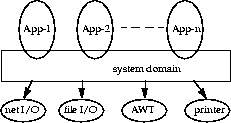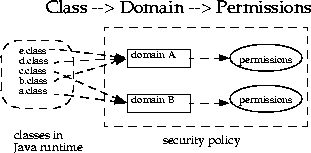A fundamental concept and important building block of system security is the protection domain [Saltzer and Schroeder 75]. A domain can be scoped by the set of objects that are currently directly accessible by a principal, where a principal is an entity in the computer system to which permissions (and as a result, accountability) are granted. The sandbox utilized in JDK 1.0 is one example of a protection domain with a fixed boundary.
The protection domain concept serves as a convenient mechanism for grouping and isolation between units of protection. For example, it is possible (but not yet provided as a built-in feature) to separate protection domains from interacting with each other so that any permitted interaction must be either through trusted system code or explicitly allowed by the domains concerned. Note that existing object accessibility rules remain valid under the new security architecture.
Protection domains generally fall into two distinct categories: system domain and application domain. It is important that all protected external resources, such as the file system, the networking facility, and the screen and keyboard, be accessible only via system domains. The figure below illustrates the domain composition of a Java application environment.

A domain conceptually encloses a set of classes whose instances are granted the same set of permissions. Protection domains are determined by the policy currently in effect. The Java application environment maintains a mapping from code (classes and instances) to their protection domains and then to their permissions, as illustrated by the figure below.

A thread of execution (which is often, but not necessarily tied to, a single Java thread, which in turn is not necessarily tied to the thread concept of the underlying operation system) may occur completely within a single protection domain or may involve an application domain and also the system domain. For example, an application that prints a message out will have to interact with the system domain that is the only access point to an output stream. In this case, it is crucial that at any time the application domain does not gain additional permissions by calling the system domain. Otherwise, there can be serious security implications.
In the reverse situation where a system domain invokes a method from an application domain, such as when the AWT system domain calls an applet's paint method to display the applet, it is again crucial that at any time the effective access rights are the same as current rights enabled in the application domain.
In other words, a less "powerful" domain cannot gain additional permissions as a result of calling or being called by a more powerful domain.
This discussion of one thread involving two protection domains naturally generalizes to a thread that traverses multiple protection domains. A simple and prudent rule of thumb for calculating permissions is the following: